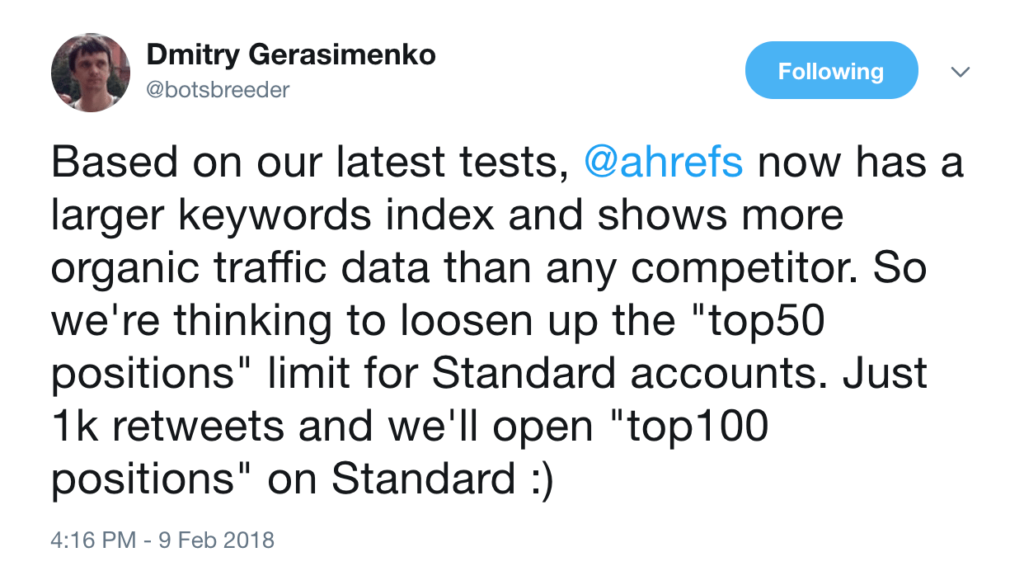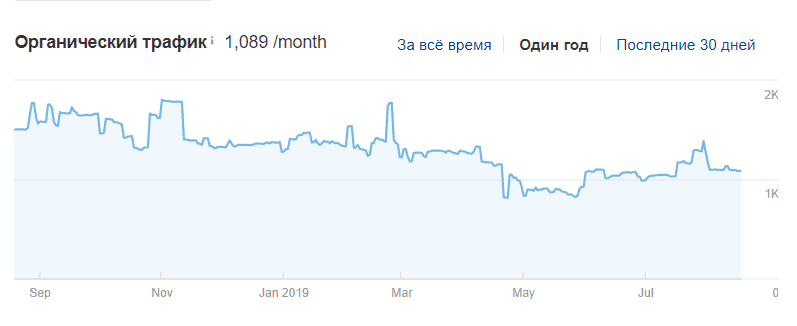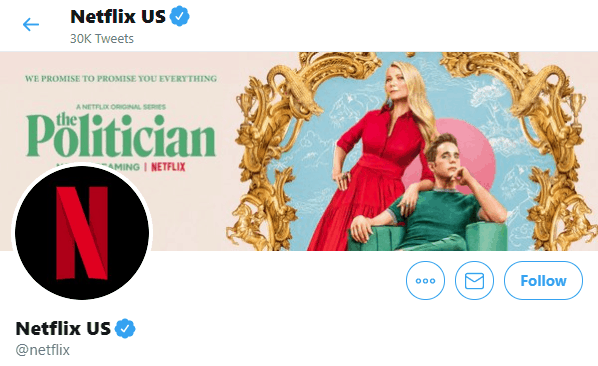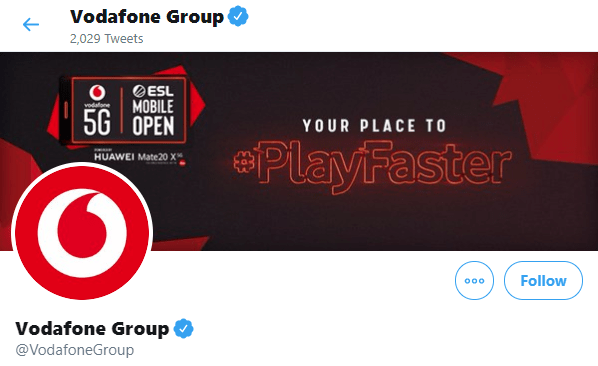The post was provided by Elena Sinyavskaya, marketer in Ahrefs.
Do you experiment with social media promotion often? Here in Ahrefs, we love coming up with new ideas to see what happens. Some end up successfully, and some do not. The main takeaway here is that we are not afraid to try new things.
CMO Tim Soulo believes that the majority of ROI in marketing cannot be measured. When no one forces you to predict payback and set specific numbers to track data at each stage of each process, you can conduct interesting marketing experiments.
We’ve learned a lot through trial and error. And now we would like to share with you some promotion ideas that worked for us.
1. Feature in exchange for retweets
In February 2018, we attempted to get 1K retweets from a post promising to loosen the data limitations on one paid subscription plan.

We would raise the bar anyway, but we wanted to draw attention to the fact, too. And we didn’t even bother about measuring the success of this experiment.
As a result, a “raw” tweet from CEO’s account got about 100 retweets in the first stage (Dmitry doesn’t have a large following on Twitter). We shared the tweet with users via Intercom notifications and in private Ahrefs Insider group on Facebook to get some boost. This raised the number of retweets to 700.
Suddenly, the counter jumped up for 500 retweets more in no time flat, to almost 1.3K in total. We suspect that someone could not stand it and bought retweets via a service like Fiverr or other. So we gave up and rolled out the update.
Looking at the tweet now, it has around 800 retweets. Looks like Twitter has deleted the retweets from bots and their retweets, which is nice.
What can you do: announce the rollout of the next update or a new feature in exchange for reposts on social networks. A share or retweet does not require much effort from the user. The desire to access a long-awaited feature may encourage users to share information about you.
2. Content recycling
Last March, we launched another experiment with multiple tweets of the same blog article. Again, English-speaking marketers widely use it across social networks.
Top blogs usually have a lot of in-depth articles and guides on a popular topic. It is the so-called “evergreen” content. Most of those articles are still relevant for months since the first day they were published. But soon, traffic to them starts to fade, especially when compared to newly published posts.
Mostly, it happens because new ones push old posts down the blog’s Home page. To avoid this traffic drop, we promote old posts across social media again and again.
Thus, we regularly published chunks from article with 75 SEO tips in separate tweets, a tip per tweet:
#SEO tip 51: Want to give your best content a quick boost?
Just add a few internal links from pages on your site with high UR (URL Rating).
This can be enough to move its ranking keyword into the top 10 and instantly boost traffic! ⚡https://t.co/hjdvViYB05
– Ahrefs (@ahrefs) July 16, 2019
For the reference: the article was published back in 2017, and since then it has been updated several times. Take a look at the traffic it still gets:

We didn’t set any goals or KPIs. However, Twitter following is quite engaged and open to new information. This is a good way to draw their attention to useful articles that they may have missed.
What can you do: Share your best articles to social networks in chunks a few times. This works perfectly for list articles and how-to articles. Tweet one piece of advice or technique from an article, e.g., once a week or several times a month.
3. Repurpose content marketing into other formats
Here’s article on how to promote a website. And here’s video on the same topic:
We’ve received so many views due to the combination of the two methods described above. We often chopped tips videos into separate mini-videos and published them on Facebook and LinkedIn to link to the full version.
We also converted some of our infographics into tweets:
When implementing #hreflang tags, remember that they are bidirectional! ⚡⚡
In other words, if you add a hreflang tag to an English page pointing to the Italian variant, then the Italian variant must return the favor with a hreflang tag pointing to the English page. pic.twitter.com/PWxiF5q9Pu
– Ahrefs (@ahrefs) July 19, 2019
That was pretty easy because infographics were already present in the blog articles on the relevant topic.
What can you do: Don’t think you’re done after clicking the “Publish” button. Having spent some time and effort on creating content marketing, extending its shelf life and repurposing your posts and images. People consume content in different ways: some like to read, others prefer video or audio. Give them a choice.
4. Twitter header experiment
The Twitter header is the first thing you see at the top of any Twitter profile. It’s an image of 1500 x 500 pixels in size.
Given its eye-catchy position and outreach potential, many businesses invest in customizing their Twitter headers for various occasions, from announcements and company news to more targeted offers and calls-to-action.
Here are some examples:


So we wondered how effective the Twitter headers are? How many people see them? And if they do, do they take into account the info on those images? And since high-quality images are expensive, does it make sense to invest in them?
The idea of the experiment was simple: use the Twitter header to announce a quick giveaway and track responses and levels of engagement.
We kept it as simple as possible: the first ten people to sent an email with the specified message from the header would get free one-month access to Ahrefs.

At that time, Twitter account had around 19.3K followers. For a start, we checked where people can see Twitter header:
- Ahrefs Twitter page;
- Search results page when searching for “ahrefs”;
- On hover of a direct mention (@ahrefs) or mention in the Twitter timeline (doesn’t work on mobile devices).
Looks promising. But we also noted a couple of potentially negative aspects:
- It is easy to abuse the opportunity by sending multiple entries from different emails to get more accounts;
- Users could spread information via other channels, thus affecting the integrity of the marketing experiment.
We uploaded the new header image on January 16, 2018, and received the 10th request for a free account a week later, on January 24.
Overall, the users’ reaction was surprisingly slow for this kind of instant-win giveaway. A spike in entries happened a week later and seemed to have been caused by two events:
- An unexpected power outage affected service. People were coming to Twitter account to ask about the downtime and, most likely, noticed the header image.
- The mention of one of the Ahrefs blog articles in a tweet from @growthhackers with over 187K subscribers.

The Twitter header marketing experiment has paid off due to content-marketing efforts, not SMM success. Users enjoyed the article on how Ahrefs increased annual revenue by 65%, decided to follow us on Twitter, noticed the header, and emailed us for free accounts. So we got both new users and reach on Twitter.
Entries from existing Ahrefs users are most likely the result of their visiting profile on Twitter. Usually, they go there to complain about something or ask a question.
Simply put, the response to giveaway was rather poor until “additional circumstances” occurred.
What can you do: Creating custom header images for every event does not pay off. But you can still create simple image ads pretty quickly, e.g., using free services like Canva or Crello. In this case, even a low conversion rate can justify the cost.
To summarize
The simpler is your approach to the idea, the easier it will be executed, and the faster you will understand whether it is worth continuing to go this way.
Remember:
- Run marketing experiments to learn something, even if you do not quite understand how to track the results.
- Keep it simple! The more effort you put into planning and analysis, the more resources you are going to spend. Sometimes it’s “cheaper” to throw things against the wall and see what sticks.
- If you don’t have resources available at the time, postpone even the most interesting ideas until better days. You might work on them later, or an alternative method of execution will come to mind.
Now, how do you keep the balance between marketing experiments and results monitoring? Are there any other tips or tricks you would like to share?
